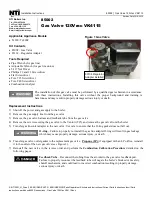
9
Flue Sensor
An optional Flue Sensor 069 can be installed on the boiler flue to measure the flue gas temperature . It is not
possible to have both a flue sensor and an indoor sensor installed at the same time as they share the same
auxiliary sensor input .
• Connect the wires to the Aux sensor terminals 8 and 9 .
FCC ID: 2AHQR-11500A
Contains FCC ID:
2AC7Z-ESP32WROOM32E
QOQMGM12P0
Contains IC ID:
21098-ESPWROOM32E
5123A-MGM12P0
CAN ICES-3 (A)/NMB-3(A)
Class 2 Circuits
Input Power:
115 V (ac) ±10%, 60 Hz, 4 W
Relays:
230 V (ac), 5 A, 1/3 hp
Calls:
24 V (ac) or Short
Operating Temperature:
32°F to 122°F (0°C to 50°C)
Use Copper Conductors Only
Wi-Fi: 802.11b/g/n, 2.4GHz
12
10/100
Ethernet
14
13
Boiler
1
Enable
16
15
Boiler 2
Enable
18
17
Comb
Air Relay
20
19
Power
N
DANGER
DANGER
To Reduce the Risk of Electric
Shock - Do not connect to a
circuit operating at more than
150 volts to ground.
Pour réduire les risques
d'électrocution choc - ne pas
raccorder à un circuit
fonctionnant à plus de 150 V à
la terre.
L
5
4
Outdoor
7
6
Cond
Sensor
9
8
Aux
Sensor
11
10
DHW
2 3
1
Ref In Gnd
Pressure Sens
Call
+
Sensor
H2065A
Smart Steam Control 289
For product literature:
Pour la documentation
du produit:
tekmarControls.com
tektra 1150-02
Designed and assembled
in Canada
N
G
L
T T
T T
Indoor Sensor
An optional Indoor Sensor 076, 077, or 084 can be installed to measure the ambient temperature in a hallway
or apartment unit . It is not possible to have both a flue sensor and an indoor sensor installed at the same time
as they share the same auxiliary sensor input .
• Connect the wires to the Aux sensor terminals 8 and 9 .
FCC ID: 2AHQR-11500A
Contains FCC ID:
2AC7Z-ESP32WROOM32E
QOQMGM12P0
Contains IC ID:
21098-ESPWROOM32E
5123A-MGM12P0
CAN ICES-3 (A)/NMB-3(A)
Class 2 Circuits
Input Power:
115 V (ac) ±10%, 60 Hz, 4 W
Relays:
230 V (ac), 5 A, 1/3 hp
Calls:
24 V (ac) or Short
Operating Temperature:
32°F to 122°F (0°C to 50°C)
Use Copper Conductors Only
Wi-Fi: 802.11b/g/n, 2.4GHz
12
10/100
Ethernet
14
13
Boiler
1
Enable
16
15
Boiler 2
Enable
18
17
Comb
Air Relay
20
19
Power
N
DANGER
DANGER
To Reduce the Risk of Electric
Shock - Do not connect to a
circuit operating at more than
150 volts to ground.
Pour réduire les risques
d'électrocution choc - ne pas
raccorder à un circuit
fonctionnant à plus de 150 V à
la terre.
L
5
4
Outdoor
7
6
Cond
Sensor
9
8
Aux
Sensor
11
10
DHW
2 3
1
Ref In Gnd
Pressure Sens
Call
+
Sensor
H2065A
Smart Steam Control 289
For product literature:
Pour la documentation
du produit:
tekmarControls.com
tektra 1150-02
Designed and assembled
in Canada
N
G
L
T T
T T
L N
G
TEMPERATURE
RESISTANCE
TEMPERATURE
RESISTANCE
TEMPERATURE
RESISTANCE
TEMPERATURE
RESISTANCE
°F
°C
Ω
°F
°C
Ω
°F
°C
Ω
°F
°C
Ω
-50
-46
490,813
20
-7
46,218
90
32
7,334
160
71
1,689
-45
-43
405,710
25
-4
39,913
95
35
6,532
165
74
1,538
-40
-40
336,606
30
-1
34,558
100
38
5,828
170
77
1,403
-35
-37
280,279
35
2
29,996
105
41
5,210
175
79
1,281
-30
-34
234,196
40
4
26,099
110
43
4,665
180
82
1,172
-25
-32
196,358
45
7
22,763
115
46
4,184
185
85
1,073
-20
-29
165,180
50
10
19,900
120
49
3,760
190
88
983
-15
-26
139,403
55
13
17,436
125
52
3,383
195
91
903
-10
-23
118,018
60
16
15,311
130
54
3,050
200
93
829
-5
-21
100,221
65
18
13,474
135
57
2,754
205
96
763
0
-18
85,362
70
21
11,883
140
60
2,490
210
99
703
5
-15
72,918
75
24
10,501
145
63
2,255
215
102
648
10
-12
62,465
80
27
9,299
150
66
2,045
220
104
598
15
-9
53,658
85
29
8,250
155
68
1,857
225
107
553
Testing the Sensor Wiring
A good quality test meter capable of measuring up to 5,000 kΩ
(1 kΩ = 1000 Ω) is required to measure the sensor resistance .
In addition to this, the actual temperature must be measured
with either a good quality digital thermometer, or if a thermom-
eter is not available, a second sensor can be placed alongside
the one to be tested and the readings compared .
First measure the temperature using the thermometer and
then measure the resistance of the sensor at the control .
The wires from the sensor must not be connected to the con-
trol while the test is performed . Using the chart below, estimate
the temperature measured by the sensor . The sensor and
thermometer readings should be close . If the test meter reads
a very high resistance, there may be a broken wire, a poor
wiring connection or a defective sensor . If the resistance is very
low, the wiring may be shorted, there may be moisture in the
sensor or the sensor may be defective . To test for a defective
sensor, measure the resistance directly at the sensor location .
Do not apply voltage to a sensor at any time as damage
to the sensor may result.
Call customer service if you need assistance with technical details .










































